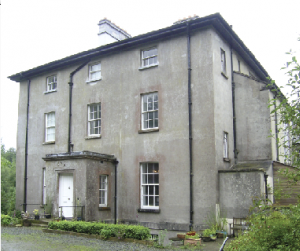Corravahan House, Co. Cavan
Published in Featured-Archive-Post, Features, Gems of Architechture, Issue 1 (January/February 2014), Volume 22
Corravahan House—a plain, square, three-storey-over-basement glebe house built in 1837–41. (NIAH)
Corravahan House, near Drung, Co. Cavan, is a mid-nineteenth-century glebe house of the middle size, constructed in the Italianate classical style. Thanks largely to lengthy occupation by the Leslie family, it is one of the most intact examples of its type and a fitting tribute to the Dublin architect William Farrell (d. 1851).
William Farrell was a prolific, if today largely forgotten, architect of the early nineteenth century. Upwards of 160 individual buildings can be attributed to him, at least in part, including 50 churches built between 1823 and 1843 when he was architect to the Board of First Fruits (fl. 1711–1833) for the province of Armagh, retaining that position when the board was reorganised as the Ecclesiastical Commissioners in 1833.

The south front features two tripartite windows with one mullioned in the style of James Wyatt (1746–1813). (NIAH)
Corravahan House was built between 1837 and 1841 for Revd Marcus Gervais Beresford (1801–85). Appointed to Drung parish by his father, George de la Poer Beresford (1765–1841), bishop of Kilmore and Ardagh, he found the existing glebe house unfit for habitation. The new house may have been paid for by their cousin, Revd John George de la Poer Beresford (1773–1862), lord archbishop of Armagh. In any case, Corravahan House was owned by the Beresford family and passed to the Revd Charles Leslie (1810–70) in 1854 on his appointment to the parish. Following Leslie’s death, the property stayed in the family for two further generations. The last Leslies at Corravahan were two sisters, Joan and Madge, who inherited from their uncle in 1930: no male heirs had survived the First World War. The sisters ‘modernised’ the house, installing central heating and electric lighting and improving sanitation, but the main fabric remained unaltered. Following their deaths in 1972, the house stood largely unoccupied until its most recent sale in 2003.
Corravahan House is a plain, square, three-storey-over-basement house. An understated porch occupies the centre of the entrance front on the east, while a shallow bow distinguishes the west front. The south front features two tripartite windows with one mullioned in the style of James Wyatt (1746–1813). Evidence suggests that the second tripartite window, projecting forward like a porch, is a later addition or at least an afterthought. The original ruled-and-lined lime render surface finish was removed c. 1890, revealing the coursed rubble limestone of the walls, which in places are 2ft thick.
The ground floor has three reception rooms and a study. The morning room in the south-east corner was converted into a library in the 1870s. The adjoining drawing room, with the projecting tripartite window, overlooks the terraced lawns to the south. The dining room on the west side includes the elegant bow. Thus the house is oriented to track the movement of the sun over the course of a day. Five bedrooms occupy the first floor, while the attic floor was a nursery until it was largely abandoned in the 1890s.
Working extensively in the area, Farrell had already completed Tullyvin House (c. 1820); Rathkenny House (1829); improvements to Ballyhaise House, including a charming gate lodge; and the now-ruined Lisnagowan House (c. 1830). The See House (1835) at Kilmore, the official residence of the bishop of Kilmore, Elphin and Ardagh, was by far Farrell’s most important domestic commission. HI
Ian S. Elliott is an archaeo-geophysical survey consultant. Series based on the National Inventory of Architectural Heritage’s ‘building of the month’, www.buildingsofireland.ie.
















